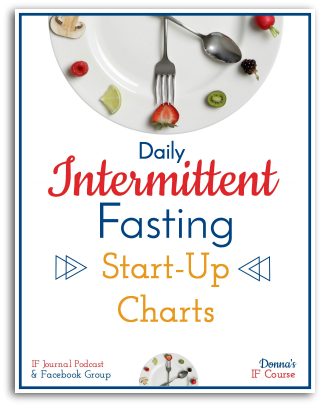For optimal viewing on a mobile device, tilt your device to landscape mode.
5 Tips & Tidbit
for OMAD/3 in Daily Intermittent Fasting
#1
What Is OMAD?
OMAD is a popular abbreviation for a Daily Intermittent Fasting (IF) protocol known as “One Meal a Day.” (Some people pronounce it Oh/Madd. I love abbreviations and cutesy names, so I’m all about the Oh/Madd!) There is a lot of confusion about exactly what this term means.
In social media groups, diehard “one plate of food” during “one half an hour period of time” people say that it isn’t true OMAD if you eat a snack during your eating window or you eat anything besides that one plate of food. Others say that OMAD means you have an eating window of somewhere between one hour and five hours in length—and you can have a snack or appetizer to open your window and then eat your meal and dessert later. It should be noted that there is another abbreviation, OPAD—One Plate a Day—for those who truly eat one plate of food every day within a thirty minute (or so) time period.
#2
What Is OMAD/3?
OMAD/3 is a shortened form that I created for the concept of thinking of your eating window in three parts. Many OMAD’ers automatically do this without thinking—but the curriculum writer/teacher in me wanted to create a catch phrase for it!
Thus, OMAD/3 is One Meal a Day divided by 3. (Teacher’s Note: Remember the fraction symbol means divide. Smile….) This means that the eating window is broken up into three “eating parts”: (1) Appetizer/salad/snack to open the eating window; (2) Main entrée a couple of hours later (depending on how long the eating window is); (3) Dessert (or snack) before closing the eating window if/when desired.
#3
Why OMAD Over Others?
Generally speaking, we lose weight with Daily IF through eating less food (creating a caloric deficit), putting our body into fat burning each day during the fasting period, and re-distributing our body’s composition into a leaner-looking physique through losing body fat and holding onto muscle. (Yay us!)
A person can lose weight with a different Daily IF protocol, such as a shorter fasting window/longer eating window of 16:8 or 17:7. However, these plans will usually involve two meals rather than one meal and may even add an extra snack in there. Thus, a 16:8 protocol would not be OMAD but could result in two meals and two or three snacks/desserts. Typically, when someone does two meals a day to lose weight, that person will also do the keto diet, low fat diet, or some other “calorie” or “carb-controlled” eating protocol along with Daily IF to achieve weight loss since they can’t count on that time period/number of eating instances to automatically create a calorie deficit (and they may not be that far into fat burning depending on what they ate yesterday).
#4
Creating Boundaries With OMAD/3
OMAD/3 is especially helpful for two types of people: The first people who are helped with this are those just starting out with Daily IF who have not gotten into “Appetite Correction” yet. Appetite Correction (AC) happens a couple to a few weeks into consistent Daily IF—sometimes sooner. It is when you naturally get full and/or want to stop eating before you overeat. It is one of the amazing benefits of Daily IF. Before AC begins, however, a new faster might find themselves “eating everything that isn’t nailed down.” OMAD/3 gives people built-in boundaries without their having to count calories or macros before AC sets in and helps them naturally eat less.
The second group of people who are helped with OMAD/3 are those who are not eating low carb or keto/do not want to count anything except for time. It is a natural boundary for food that can help us keep the amount of food we consume in check when we don’t want to consider the type of food (i.e. low carb, high fat, low calorie, etc.). Yes, we can eat whatever we want in our eating window and still lose weight—but we can’t eat huge amounts and/or non-stop during that window.
#5
Choosing Foods for OMAD/3
One of the things that many people love about Daily Intermittent Fasting is the freedom to eat whatever they want—oftentimes for the first time after many years of attempted dieting and deprivation. (Daily IF is “short term sacrifice for long term success”!) So if we can eat whatever we want during IF, why is this a point titled “Choosing Foods for OMAD/3”? I am thrilled to be teaching IF from the standpoint of eating whatever you enjoy. It is much-needed and long-awaited for many of us 40-60 year olds who have struggled with dozens of diets throughout our adult lives.
However, I like to teach three benchmarks for choosing your foods during OMAD/3: (1) Getting nutrition in (i.e. fruits, veggies, and proteins for sure!); (2) Feeling great (no carb comas, brain fog, or tummy troubles); and (3) Eating what you enjoy. For me, this means that on most days, I open my window with a snack/appetizer/salad this is nutrient-dense and low carb—salad, soup, cheese and low carb crackers, leftover meat, green beans, nuts, etc. This isn’t a hard and fast rule. I just know that I will feel great until my meal (which is whatever I want to eat that doesn’t make me feel bad) AND I won’t crave foods while I’m waiting for my meal (since low carb foods do not make me crave). Then I have my meal and oftentimes a dessert of my choice—one dessert!
Resources
1) What Is OMAD? IF Journal podcast/videocast week 5
2) What Is OMAD/3? Slideshow: 5 Tips Creating Simple Boundaries in IF
3) Why OMAD Over Others? Slideshow: 5 Reasons Might Need Shorter Eating Window
4) Creating Boundaries With OMAD/3 IF Journal podcast/videocast week 11
5) Choosing Foods for OMAD/3: Slideshow: 5 Ways to Start IF Hours and Options
Find ME–and Find Out More About Daily Intermittent Fasting!
(1) FB Group for Support and Daily Help
(2) Blog with all videos, articles, 5 Top Tips for IF Slideshow, and more.
(3) IF Journal Podcast at iTunes
(4) YouTube channel
Thanks for Viewing My…..
5 Tips for Daily IF Slideshow
Find More of These Weekly Slideshows here at donnareish.com
In the slideshow above are a couple of links to books I use and love. I am an affiliate for Amazon.com. If you click on the links above I will earn a small commission. Thank you for your support of this blog!











Hi can plant based supplements be taken while in the fasting period? Thanks R